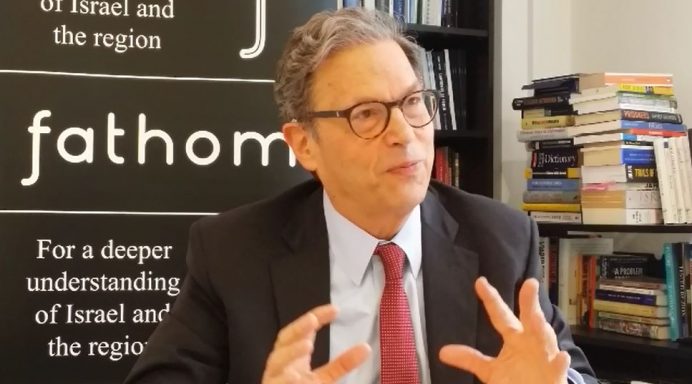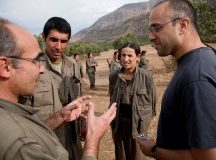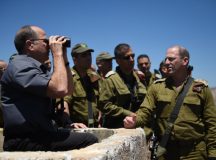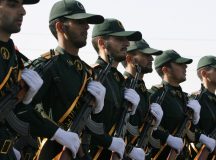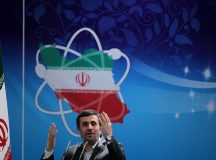Jonathan Paris argues that we underestimate the determination and the capacity of the Iranian regime to project power in the region, as embodied in the figure of General Qassem Soleimani (Qassem), the head of the Al Quds division of the Islamic Revolutionary Guard Corps (IRGC). According to Paris we also fail to register how much US-led interventions in the Middle East have helped Iran. ‘The IRGC has been very clever. They come in after their enemies – Saddam’s Iraq, the Taliban, and, most recently, ISIS – have been defeated by the US-led coalition, and they fill the political vacuum left by the departing American forces.’ And yet, hubris partly has led Iran to make several strategic mistakes that can be exploited to roll back its march across the region. Paris was speaking to Fathom in London on 15 March 2018 before the recent air strikes in Syria. Below is an edited transcript.
The Iran nuclear agreement of 2015, known as the JCPOA, was a trade by Iran to get rid of sanctions that were devastating their economy in exchange for a green light to pursue their regional ambition: long-term Iran-led Shia expansionism.[i] Iran saw the nuclear deal as being in its interest. The agreement gives Iranian Supreme Leader Ali Khamenei a hedge or option to develop Iran’s nuclear weapon in the coming years. In the meantime, Khamenei’s revolutionary guard are spearheading a regional takeover in the troubled Arab world, focusing on Syria, and that is our subject today.
Because the Obama administration was fixated on securing the nuclear deal, they gave a green light to Iran to do all sorts of things in the region. And this took place in 2013-15, when the Syrian rebels were at their peak and Iran’s ally, Syrian President Bashar al-Assad, was near his end. It was looking very grim for the Syrian regime, but they were able to call on Iran to backstop them. General Qassem Soleimani (Qassem), the head of the Al Quds division of the Islamic Revolutionary Guard Corps (IGRC), persuaded Putin in 2015 that getting Russia involved in Syria was a great opportunity to save Bashar. Putin for reasons of his own did that.
Qassem Never Sleeps
To give you an idea of how Qassem operates, he is a workaholic who is reputed to sleep only three hours a day. He has been spreading Ayatollah Ruhollah Khomeini’s sectarian Shia ideology since the Iran-Iraq war in the 1980s. Recently in October 2017, following the Kurdish referendum in northern Iraq, which was widely condemned by the international community, as well as by Iran, Qassem was able to persuade a key Kurdish clan, the Talabanis, rivals of the dominant Kurdish group in Iraq known as the Barzanis, to allow the IRGC and their Iraqi Shia proxies to enter the Kurdish state (KRG). Qassem in turn facilitated the recapture by the Iraqi government’s Shia militias of Kirkuk and other territory that were taken by the Kurds at the beginning of the war against ISIS.
Qassem moves quickly on the ground and does not talk in public too much. His move on the Iraqi Kurds took place less than a fortnight after President Trump’s mid-October speech targeting Iran for its malign activities in the region.
The genius of Qassem is that he has created a transnational highly mobile group of Shia militias from Lebanon to Pakistan with the ability to fight and die in Yemen on one day, Syria on the next day, and Iraq on the following day, all in pursuit of the Supreme Leader’s objectives. A block-Iran coalition comprising any of the US, UK, France, Saudi Arabia, Jordan, UAE, Bahrain, Israel and Egypt, can learn from Qassem’s successes and organise an analogous set of Sunni militias in the eastern and southern parts of Syria. Such a coalition could supplement and enhance the current US-supported SDF (Syrian Kurds and local Sunni Arabs) in trying to halt the Islamic Republic of Iran’s highly destabilising sectarian-infused imperial expansion into the Levant.
Yet so far the Western response to the Iranian threat has been much talk and little action. There are glimmers of an emerging strategy, but until now the US has been operating on the ground de facto within former President Obama’s policy of limited intervention. The title of a recent panel discussion at a major US think-tank, ‘Are we overinvested in the Middle East?’ sums up the current thinking in policy circles. As President Trump himself said, ‘We are going to stop spending US$7 trillion abroad and start focusing on infrastructure at home.’
Responding to Iran
What has to happen in order to contain and roll back Iran in the Middle East, and particularly in Syria? Is there a formula for the US to be able to engage in the Middle East in a way that works? What will not work is another Iraq or Afghanistan. But can the US find partners to do the heavy lifting and the fighting? I think they have. One of the good news stories of the last few years is that Syrian Kurds are effective ‘boots on the ground’ – they retook Mosul in Iraq and Raqqa in Syria from the Islamic State (ISIS) in 2017. Their tenacity in urban fighting was demonstrated in their iconic resistance at Kobane on the Turkish border aided by US air strikes in the autumn of 2014, a battle that began the partnership between the Syrian Kurdish forces and the US in ultimately defeating ISIS.
Another partner of the US is Saudi Arabia, whose anti-Iranian focus is increasing. Saudi Arabia in turn can bring into the pro-US alliance interested moderate Sunni Arab states. Still another US partner in the Syria mix is Israel, which provides the US an anchor of stability in the region that mitigates the necessity to send US troops there. If President Trump seriously wants to reduce US troops in the region, then US policy and diplomacy will likely encourage these local partners and allies to work together.
The Emerging Israeli-Iranian conflict
Is there going to be war between Israel and Iran? They came close to one in February this year when the Iranian IRGC sent what Israeli sources describe as an armed drone from their T-4 airbase facilities in Syria into Israeli airspace. The drone was quickly shot down, followed by an exchange of hostilities between Israel and the Syrian air defences. Israel needs command of the skies, something which has been central to Israel’s security strategy since its founding 70 years ago. The Israelis had sent a message that ‘we know where the drone came from and we took out the trailer where the IRGC drone operations team was working’.
That does not mean that every Iranian base in Syria is a threat to Israel. Some bases contain Iraqi, Afghani, Pakistani and, of course, Lebanese Hezbollah militias that are fighting Syrian rebels. What happens to those foreign militias when the last Syrian rebels are defeated? If the Iranians are smart, the one destination which these militias will avoid is Israel.
Israel has three red lines. First, no Iranian and Iranian proxies, Hezbollah included, on the Israeli-Syrian border and no massive troop concentrations near Israel. Second, no Iranian-sponsored precision-guided missiles that can be used to hit Israel, especially critical Israeli infrastructure. Third, no Iranian military entrenchment in Syria that threatens harm to Israel.
There will be occasional February-type Israeli strikes in the future, but as long as Iran does not cross those three red lines, it is unlikely that Israel and Iran will start a war. Hezbollah does not want a war so close to national elections in Lebanon on 6 May 2018. The government of Israel does not want a war mainly because it does not want to pay a domestic civilian price from the likely damage of incoming Hezbollah missiles.
What does Iran want in the Levant? An ayatollah once told me in London in 2004 that Iran does not want a war with Israel, but they want to have sticks (Syria, Hezbollah, Hamas and Palestinian Islamic Jihad) to provoke and distract Israel when necessary so that Israel will think twice about targeting Iran’s nuclear weapons infrastructure in the future.
Piggybacking on the West
In recent months, Qassem and the IRGC have become buoyed with success from Assad’s improving fortunes against the Syrian rebels. One can see a pattern in the Middle East since 2003. The reality is that US-led coalitions keep defeating not Iran but Iran’s enemies, such as Saddam’s Iraq, the Taliban, and, most recently, ISIS. The IRGC has been clever – they come in after their enemies have been defeated by the US-led coalition, filling the political vacuum left by the departing American forces. Until now, they have managed to stay under the radar, while the US did the heavy lifting in manpower and treasure. The IRGC success on the ground has been in coordinating multinational Shia militias and Russian airpower to defeat untrained Sunni Syrian rebels who are without an air force or superpower ally. With that pseudo-success comes greater IRGC ambition on both sectarian and imperial levels. This is what we are seeing now in Iran’s attempt to take over a hollowed-out Syria.
The Islamic Republic of Iran have made four strategic mistakes
- First, the Iranian leadership thought that the Obama Administration’s policy of retrenchment from the Middle East and allowing Iran to do whatever it wants in Syria and the wider region would continue forever. They did not count on a Trump, Pompeo and John Bolton replacing Obama and John Kerry in Washington. Even the Europeans are starting to complain about the IRGC’s malign regional activities.
- Second, the surprising protests erupting in hundreds of cities and towns in Iran at the end of 2017 and beginning of 2018 revived global awareness of the Islamic Republic’s Achilles heel. One street slogan was repeated over and over again: ‘I die for Iran not for Palestine or Lebanon’. The impoverished Iranian people want more butter not more guns. The people are telling the ayatollahs to stop spending so much of the money from sanctions relief and Iranian oil exports on IRGC adventures abroad. They are saying: Bring it home and make Iran work again. Fomenting ‘Resistance’ against far away Israel does not appear to be a priority of the Iranian people.
- Supreme Leader Khamenei responds that it is better to fight enemies far away than to fight them at or closer to home. But here is the problem with his thinking: when you create strategic depth for yourself, you may think you are increasing your security, but you are also increasing insecurity for your neighbours. This is what has happened in Syria with Iran’s attempt to entrench itself there militarily. The IRGC strategy of entrenching itself militarily in Syria is making Israel insecure. In response, Israel is naturally looking for ways to make the Islamic Republic insecure. Will IRGC deployment of hundreds of Iranian missiles in Syria to threaten north Tel Aviv make north Teheran more or less secure? This is the Islamic Republic’s third strategic mistake.
- A fourth strategic mistake is the geographic disadvantage Iran finds itself against Israel in Syria. The province where Damascus is situated is much closer to Israel Defense Forces (IDF) bases in Israel than it is to Iran. In any kinetic activity in the northern theatre, the IRGC and its proxies will be highly exposed. The more bases the IRGC establishes, the more targets they provide the Israeli air force. This phenomenon creates a paradox whereby the more the Iranians appear to win in Syria, the more they lose. The question is whether IRGC moves to further entrench Iran in Syria, and IDF moves to resist and strengthen Israeli deterrence will result in unintended consequences, similar to the 2006 Israeli-Lebanon war, where incidents initiated by Hezbollah on the border with Israel escalated into a war.
A new US Secretary of State
What can we expect from new Secretary of State, Mike Pompeo? He was a captain for the US army and a former congressman from Kansas who strongly opposed the JCPOA in 2015. He comes straight from directing the CIA, which is one of the toughest jobs in the US government. He is a better communicator than his predecessor, Rex Tillerson, and has a sense of mission that had evaded the State Department under Tillerson, whose only mission seemed to be a reorganisation to make the Department more efficient. Efficient to do what? Diplomats do not make widgets, they do diplomacy, and effective diplomacy has a set of articulated goals. The US goal in the Mideast for the past several years is ending with the fall of ISIS. Now it is time to look ahead strategically to meet the challenges of the next few years.
Unanswered questions
Israel’s Benjamin Netanyahu has had a decent relationship with Russia’s Vladimir Putin. Given the Western fallout from the spy poisoning in the UK, it is difficult to think of any other Western leader who has as good a relationship with Putin as Netanyahu. What happens to the Israeli-Russian relationship if Netanyahu steps down is unclear but not all that worrisome. What happens when Bibi has to choose the Trump Administration over Putin whenever the two superpowers come to loggerheads in Syria is a more fateful question.
Russia wants a Pax Russiana, a Russian-forged peace that consolidates Putin’s success in Syria. This requires the stabilisation of the Syrian regime, with Bashar al-Assad or someone like him as the head. Russia does not share the Iranian/Hezbollah interest in opening up a second front against Israel along the 45 mile Syrian-Israeli border on the Golan Heights.
Iran appears to want something different, something more. Will we see General Qassem Soleimani’s ambitious IRGC goal to take over Syria and threaten Israel, or a more limited Plan B inspired by President Rouhani’s government, which seems less and less enthusiastic about the military, political, economic and social costs of IRGC’s regional forays?
Either way, it is vital that the West understand that the Islamic Republic of Iran does not look at the Middle East the way outsiders do, as a region of separate states. The Islamic Republic sees the land mass extending westward from their border with Iraq to the Mediterranean as potentially one large Shia canvas. In that sense they are closer to the imperial Ottoman vision than to the Westphalian Sykes-Picot formula of separate states.
[i] This note has been added by Jonathan Paris in April: Since this talk on 15 March, much has changed in Syria. A triumvirate of the US, UK and France have carried out a bombing of three chemical weapons-related sites in Syria on 14 April, attempting to re-establish an international norm against the use of chemical weapons. President Macron of France has weighed in, along with the Crown Prince of Saudi Arabia, to urge President Trump to stay in eastern Syria, albeit with greater support from US allies. Not leaving a vacuum in eastern Syria is critical although not indispensable to Israel’s ongoing effort to restrain Iran’s entrenchment in Syria. On his recent trip to Israel, US Secretary of State Pompeo said: ‘We remain deeply concerned about Iran’s dangerous escalation of threats to Israel and the region, and Iran’s ambition to dominate the Middle East remains. The US is with Israel in this fight, and we strongly support Israel’s sovereign right to defend itself.’
But much remains the same. Russia struggles with competing interests. On the one hand, Russia seeks to punish Israel for supporting the US-led attack and behaving like a US ally. Indeed, just five days before the US-UK-France bombing on 14 April, Israel on its own attacked the Iranian sector of the Syrian military base called T-4 in the Homs region for a second time. Another strike attributed to Israel by media sources in the region was carried out on two Syrian military bases suspected of housing Iranian weapon storage facilities, surface-to-surface missiles and Iranian forces on 29 April.
On the other hand, Russia has an interest in restraining Iran’s entrenchment in Syria. If the Iranians are not constrained, the emerging Israeli-Iranian conflict is likely to escalate, putting in jeopardy Russia’s strategic goals in Syria including the survival of Bashar al Assad.
In the coming months, Israel is likely to intensify its support in the Syrian Golan of anti-Assad Sunni militias who are not beyond the pale in terms of extremism, in the hope of delaying and maybe preventing Iranian proxies embedded in Assad’s forces from reaching Israel’s current border. Despite rumours of Russian S-300s being sent to Syria (more to punish the US than Israel), the Israeli air force will undoubtedly continue to bomb IRGC military assets throughout Syria. Tensions are escalating in the region just as the fate of the JCPOA is coming to the fore.

